| Index | Click
on an image to enlarge it (JavaScript is required). |
|
Sat 10th June 2006
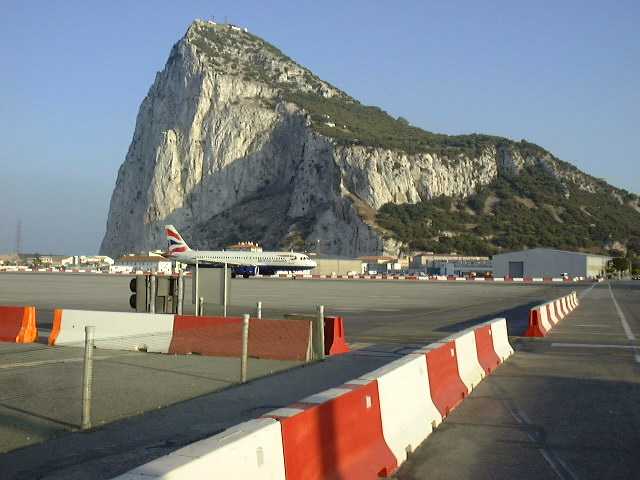 From
sunny London to sunny Gibraltar in a couple of hours, plus another couple
of hours to get back through the border traffic jam from Spain where we
had to pick up the hire car. If I had read the guidebook I would have
known that it was pointless to have a car in Gibraltar where it is easier
to walk. From
sunny London to sunny Gibraltar in a couple of hours, plus another couple
of hours to get back through the border traffic jam from Spain where we
had to pick up the hire car. If I had read the guidebook I would have
known that it was pointless to have a car in Gibraltar where it is easier
to walk.
The hostel we have booked into is deserted so we walk into the nearest
square for some lunch. The large square is packed with football fans
waiting for the 3 pm kick-off which will be displayed on a screen the size
of a small house.
The centre of town is pedestrianised and nice to walk through but down
towards the coast it becomes obvious that this is a shipping port and
British naval base. The small botanical gardens are a pleasant place to
stop for a kip to catch up after our early morning rise.
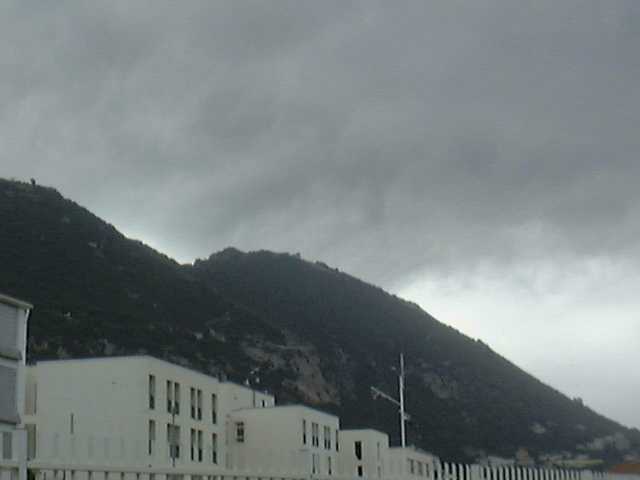 As
we have a car we decide to drive round the rock to see all there is to see
which does not take long as it is only 6 km long and 1 km wide. Past the
lighthouse on the southernmost tip, the road runs up the eastern side a
little before it is fenced off but on the way back up the western road we
find a way up and as the rock is almost half as high as it is wide, this
is by far the most interesting aspect. After only a few million revs of
the engine we are experiencing fantastic views down to the town and out
over the water to the southernmost part of Spain and indeed, Europe. All
the tourist attractions are closed by now but a few stops at lookout posts
and gun emplacements are entertainment enough for us in the evening
sunshine. As
we have a car we decide to drive round the rock to see all there is to see
which does not take long as it is only 6 km long and 1 km wide. Past the
lighthouse on the southernmost tip, the road runs up the eastern side a
little before it is fenced off but on the way back up the western road we
find a way up and as the rock is almost half as high as it is wide, this
is by far the most interesting aspect. After only a few million revs of
the engine we are experiencing fantastic views down to the town and out
over the water to the southernmost part of Spain and indeed, Europe. All
the tourist attractions are closed by now but a few stops at lookout posts
and gun emplacements are entertainment enough for us in the evening
sunshine.
Back down in the town there are lots of English pubs all selling fish and
chips and a selection of English beers, at least, the ones that travel
well but are tasteless. Gibraltar looks like a Mediterranean town but in
most other respects is an English one. |
|
Sunday 11th June 2006
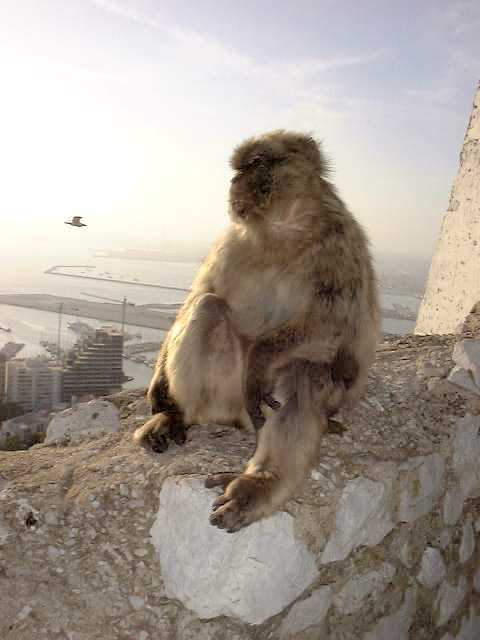
The compliment of English shops includes Marks & Spencer's and
Morrissons (still badged as Safeway here) so we pick up some lunch and
walk to the cable car for a ride up to the top of the rock. There is a
cafe on the top patrolled by Barbary Macaques (apes) ready to steal any
food that foolish tourist attempt to eat so we save the packed lunch for
dinner and eat lasagne in the cafe instead.
There is a fair breeze blowing today which is forcing moist air up the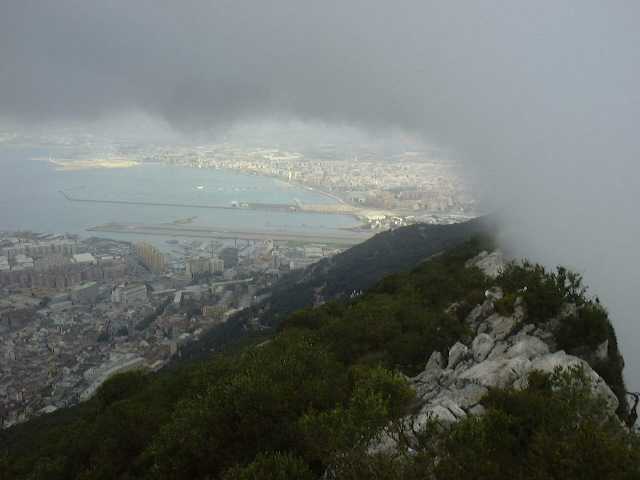 eastern face of the rock. Before it reaches the top it condenses into
cloud that jets up over the summit like there is a big kettle on the boil.
The cloud swirls about in large eddies before spreading out to form a
large canopy that shades the whole town from the sun. When we look down
the eastern face we can see down through the cloud to the sunny beaches
below. The seagulls seem to like the ridge-lift and float about in it all
day.
eastern face of the rock. Before it reaches the top it condenses into
cloud that jets up over the summit like there is a big kettle on the boil.
The cloud swirls about in large eddies before spreading out to form a
large canopy that shades the whole town from the sun. When we look down
the eastern face we can see down through the cloud to the sunny beaches
below. The seagulls seem to like the ridge-lift and float about in it all
day.
After a pleasant stroll along the ridge top path we arrive at St.
Michael's Cave. The rock is described as a chunk of limestone that was
rolled on top of younger rock during some extreme geological activity a
few million years ago. The limestone has since been worked upon by the
magic of acid rain to form caves of stalactites and other pretty stuff.
At the northern edge of the rock, in the 1780's, the British dug siege
tunnels through the rock with port holes so that they could fire canons
out upon the Spanish and French forces trying to recapture the rock. Now
there are 33 miles of tunnels but we did not explore them all. Thankfully,
the stroll back to town was all down hill. |
|
Monday 12th June 2006
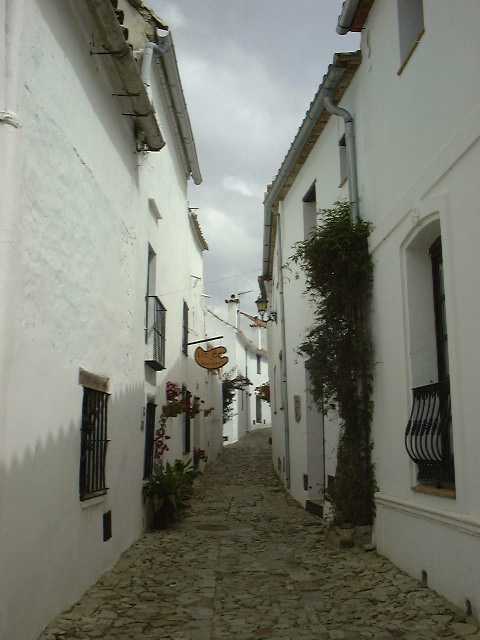 It
was another windy day as we set out from this little bit of Britain,
stopping only to stock up on provisions, and head out into the Andalusia
region of Spain. It
was another windy day as we set out from this little bit of Britain,
stopping only to stock up on provisions, and head out into the Andalusia
region of Spain.
Our oddly shaped little Citroen C2 skittered merrily down the wrong side
of the road, but that is OK because they all drive on the wrong side of
the road here. In no time we were out in the country and up in the
mountains heading for Jimena in 'de los Alcornocales', 'Parque natural'.
After very few kilometres we could not resist taking a sidetrack down a
tiny road to Castillo de Castellar. The deserted, windy road took us past
a lovely lake and up a steep hill to a castle. Inside the curtain wall
they seemed to be converti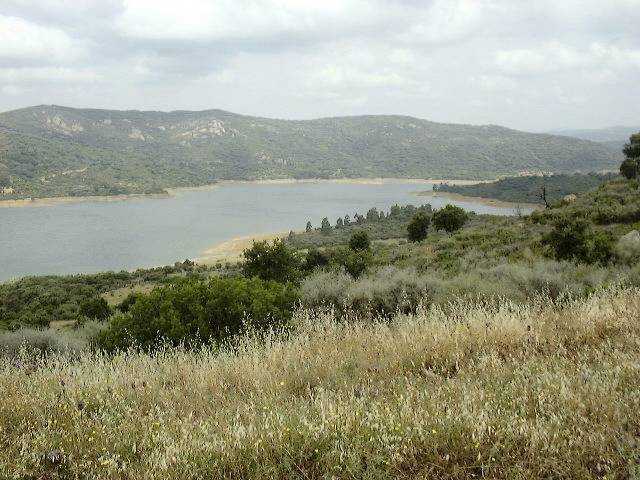 ng
the tiny contained village into holiday apartments. It looked like it
would be a nice place to stay, but not for us today. Just outside the
walls a cafe served up a nice cafe Americano while at the bar two men
cooked sausages over their own personal barbecue of flames in what looked
like a gravy boat. ng
the tiny contained village into holiday apartments. It looked like it
would be a nice place to stay, but not for us today. Just outside the
walls a cafe served up a nice cafe Americano while at the bar two men
cooked sausages over their own personal barbecue of flames in what looked
like a gravy boat.
Further up the road, just past Los Angeles, we reach Jimena de la
Frontera, with its own castle and village on steep slopes. Apart from a
few men sitting outside bars there is no one about as we meander to the
top of the hill to the castle. Muslims seem to have been in this area
quite allot in the 1300's, building or adding to castles in the area.
The mountainous, tree covered countryside with streams and pools looks
like perfect rambling country so we set off to find a place to stay. In
the town, a sign points to a camp site which turns out to have log cabins
for rent, and nice little log cabins they are too. We seem to be the only
ones here which suits us just fine so we make ourselves some pasta and
settle down to drink red wine in the evening sun. |
|
Tuesday 13th June 2006
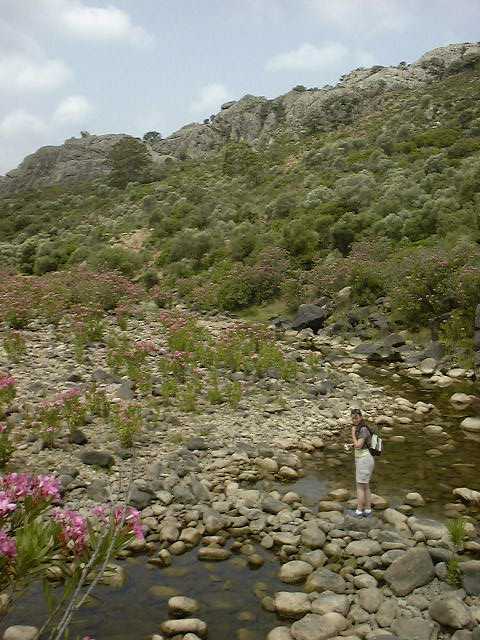 Having
our own cabin Having
our own cabin 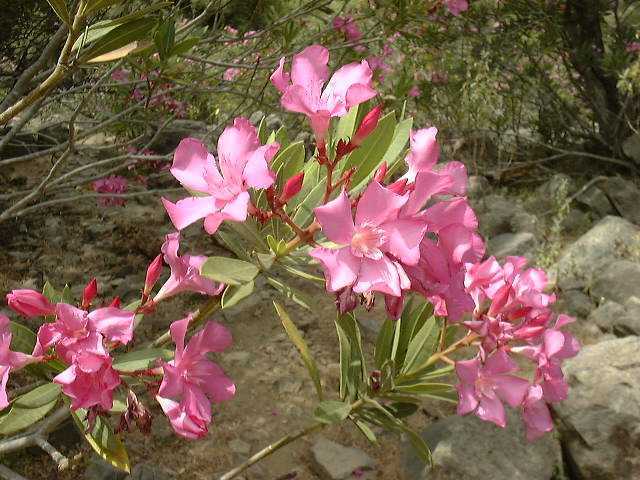 allowed
us to rise more casually and besides, our planned walk was just outside
the door. We headed down the valley to the river (Rio Hozgarganta) below
where a bushy plant with bright pink flowers seemed to thrive. The river
was just a stream between pools at this time but the marks on the banks
suggested it flowed in torrents on the odd occasion. Faint paths above the
high tide marks guided us through the thick and spiky undergrowth. Most
all the flora and fauna we could see were unfamiliar and most of the
vegetation has spikes to scratch at the passing rambler. Turtles and
little green frogs plop back into the water as we approach, lizards
scuttle under rocks while birds of prey float overhead trying to spy them.
There is little evidence of human population, not even the sound of road
traffic that is ever pervasive in England. allowed
us to rise more casually and besides, our planned walk was just outside
the door. We headed down the valley to the river (Rio Hozgarganta) below
where a bushy plant with bright pink flowers seemed to thrive. The river
was just a stream between pools at this time but the marks on the banks
suggested it flowed in torrents on the odd occasion. Faint paths above the
high tide marks guided us through the thick and spiky undergrowth. Most
all the flora and fauna we could see were unfamiliar and most of the
vegetation has spikes to scratch at the passing rambler. Turtles and
little green frogs plop back into the water as we approach, lizards
scuttle under rocks while birds of prey float overhead trying to spy them.
There is little evidence of human population, not even the sound of road
traffic that is ever pervasive in England. |
|
Wednesday 14th June 2006-11-25
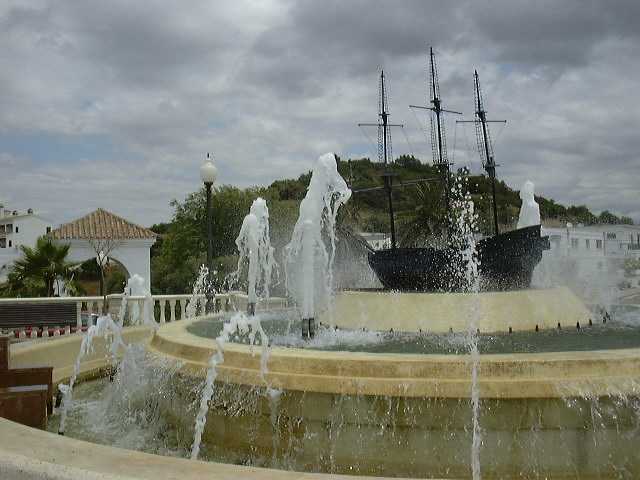 We
were lulled to sleep last night by a rain storm with thunder and
lightening that just about rained itself out by the time we got up. An
ideal day for a road trip. We
were lulled to sleep last night by a rain storm with thunder and
lightening that just about rained itself out by the time we got up. An
ideal day for a road trip.
We travelled north from Jimena where our cabin is, along an all but
deserted mountain road, through wonderfully scented pine forests and cork
oak trees, stripped of their lower reaches of bark. From the top of each
mountain were views of yet more forested mountains, sometimes streaked
with rocky outcrops.
We headed for a lake and a village called Garcisobaco thinking of lunch,
but the road was closed off and derelict with only gates to a private
house of the same name. The lake seemed to be submerged fields with fences
and trees, surround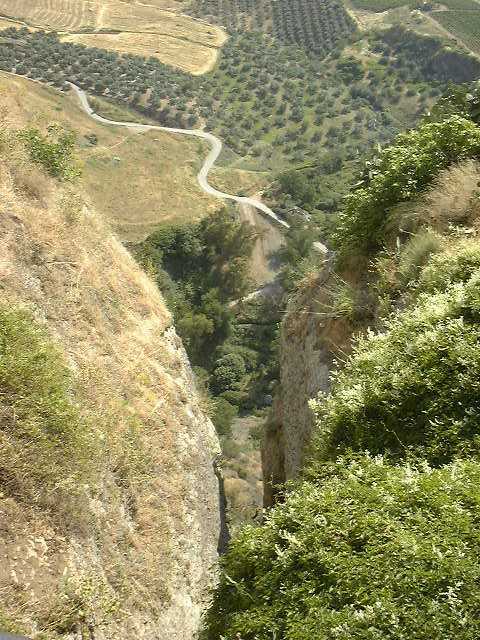 ed
by mud flats so we decided to press on. ed
by mud flats so we decided to press on.
At Ubrique we stopped to wonder at a fountain far more wonderful than the
surrounding town. A model of a ship in the centre of a circular fountain
that played varying jets of water all about it, a little out of place here
in the mountains so far from the coast? Across the road in a large but
quiet café we ordered a flan and a tart from the menu. We had hoped for
savoury snacks but what turned up was crème caramel and cheesecake, oh
well!
Through yet more kilometres of stunning scenery we arrive in Rhonda,
recommended by one of Tracy's patients as a pretty place to visit. We park
up in a notably dull part of town and head off on foot to find some proper
lunch. In one of the pedestrianised main streets we find some 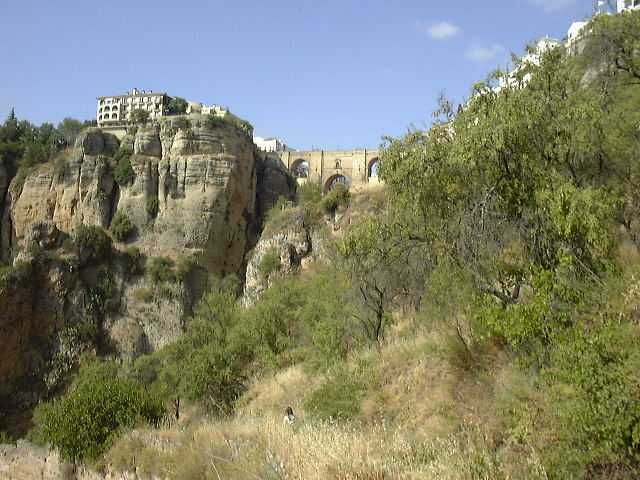 real
tapas in a grotty little bar that is empty and half asleep. The dried meat
sausage in lard is a bit off putting but OK once the lard is scraped off.
The anchovy and potato dishes are quite good. Judging by the size of some
of the girls walking by the window, lardy sausages must be a real
favourite. Just as back home, some have made their wobbly bits into a
fashion statement by tightening a belt around it to form a double water
balloon effect, very fetching. real
tapas in a grotty little bar that is empty and half asleep. The dried meat
sausage in lard is a bit off putting but OK once the lard is scraped off.
The anchovy and potato dishes are quite good. Judging by the size of some
of the girls walking by the window, lardy sausages must be a real
favourite. Just as back home, some have made their wobbly bits into a
fashion statement by tightening a belt around it to form a double water
balloon effect, very fetching.
The end of the street opens out a little, mainly in a downward direction.
So this is why Rhonda is described as so pretty, the old town is perched
on an outcrop of rock with sheer drops all over the place. Some long
forgotten mayor must have thought it would be a great tourist attraction
if they built a scenic bridge across the gorge between the two halves of
the old town. It worked! We even trekked down a steep path to get a better
view. Or was it the bull fighting that Made Rhonda so famous, who knows?
An empty tourist restaurant served us a nice pan of paella before we set
off to cross the windy mountain passes in the dark back to our cabin. |
|
Thursday 15th June 2006
We are reluctant to leave our cabin it is so nice (apart from the little
flies whose mission is to tickle us to distraction) so we arrange to stay
for another couple of days.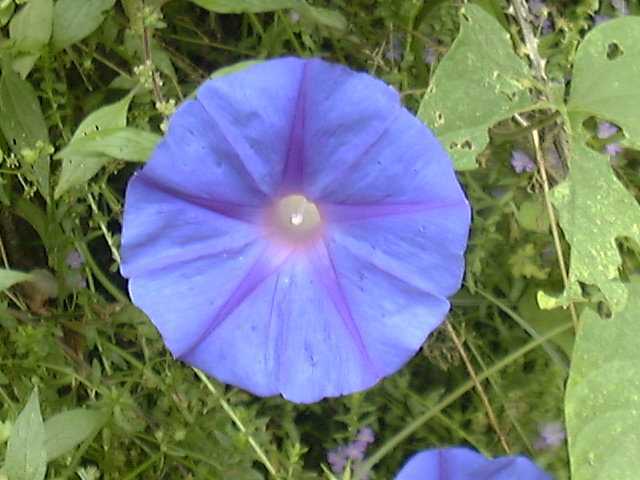
We set off down another walking path that takes us down the Rio
Hosgarganta towards Jimena. There are a few houses this way, nestled into
the hillside just out of reach of the river. A bit further down we find a
very old stone built water mill complete with water race and mill stones.
Not surprisingly the water wheel was missing and a bat had taken up
residence. It was hard to see how the mill could work except when the
river was flooding but perhaps that always happened just after the grain
harvest. There are a number of other building along our path by the river,
some derelict, others looked lived in or perhaps were just barns.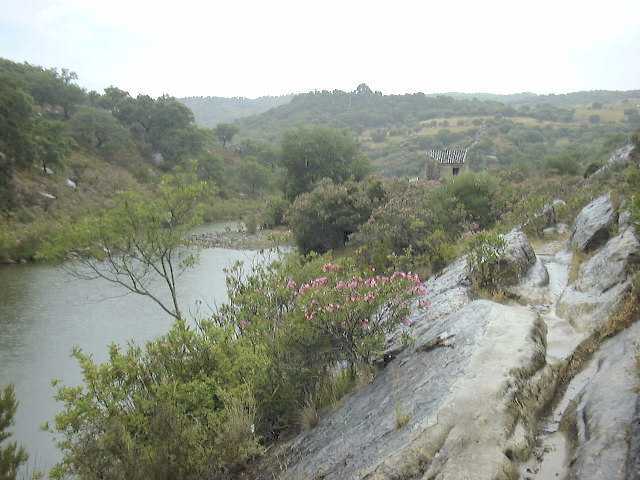
Near the town we came across an odd construction. It was described on a
signpost as 'canal' but it was 5m deep and only 3m wide and ran along the
bank of the river. Sluice gates in the outer wall to let water in or out.
Strangely, a broken wind-surf board was at the bottom. In all, it may have
been a quarter of a mile long. My best guess is that it was designed to
catch water during the flooding of the river for use in the town during
the subsequent dry period. Speaking of which, as we sit down to eat our
lunch of bread and sardines, we hear thunder over the mountains and the
rain starts to fall. The rain seems to bring out the scent of the flowers
even more and is only a minor inconvenience as we head back along the
track. Along the way we meet a white horse. All the hair is worn off his
shoulders and the skin is scabby and sore. His front legs are hobbled with
a piece of rope which has worn his ankles to sores with a trickle of blood
running down one ankle. The least we can do is untie his legs and tell him
to be glad he is not a bull.
Back at the cabin we are visited by a plague of cats that start to follow
us about. This cannot have anything whatsoever to do with Tracy feeding
them. The mini-monsoon has abated for a while so we walk into town in the
warm moist evening air to eat at 'La Casca', a little restaurant Tracy
noticed on our first day, and very nice it was too.
The town is just as you would expect a small Spanish town to be, all white
washes walls and terracotta roof tiles. The streets are narrow and often
steep with minimal footpaths. Locals sit in the street and chat or sit
inside with their doors open. Even at 10pm a little food shop is open to
provide us with tomorrows breakfast. |
|
Friday 16th June 2006
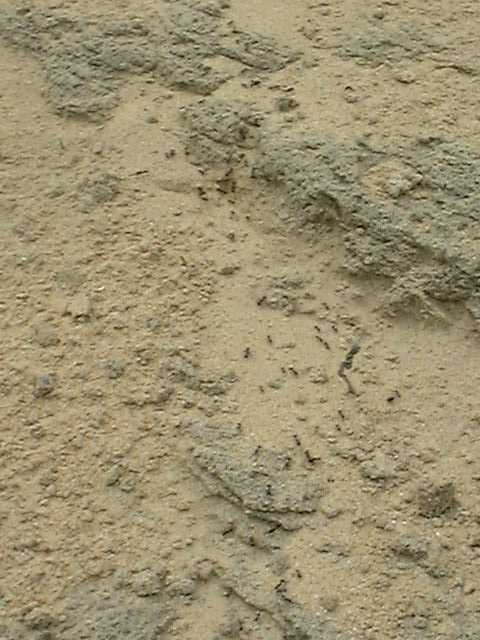 Another
road trip today, this time to the west through the mountains and out onto
the flat agricultural lands of the province of Cadiz. At Barbate on the
Atlantic coast we turn north and fins a parking spot where we can walk on
the sandy soil through the pine trees and down to the coast. I call them
pine trees because they smell right and have needles but the branches form
a globe on a stick rather than the usual upward pointing arrow shape. On
the sandstone cliff edge we find a good spot with a view for our lunch of
bread and olives. The sound of the breaking waves, the afternoon sun and
the warm wind were so soothing that we succumbed and joined the rest of
Spain in a siesta. Another
road trip today, this time to the west through the mountains and out onto
the flat agricultural lands of the province of Cadiz. At Barbate on the
Atlantic coast we turn north and fins a parking spot where we can walk on
the sandy soil through the pine trees and down to the coast. I call them
pine trees because they smell right and have needles but the branches form
a globe on a stick rather than the usual upward pointing arrow shape. On
the sandstone cliff edge we find a good spot with a view for our lunch of
bread and olives. The sound of the breaking waves, the afternoon sun and
the warm wind were so soothing that we succumbed and joined the rest of
Spain in a siesta.
We watched as a little motorboat sped out from the harbour into the bay.
One of the two occupants went skin diving while the other kept the boat. I
dosed again. The cliff we sat on was mainly sandstone that had mainly
turned back into sand making the climb back up to the car quite arduous.
The road north to El Palmer seems to be packed with hostels. Many look
closed. The one we chose to stop at was not serving food so we head on to
Vejer de la Frontera, a nice but typical looking town perched on a hill
with a church on the top. All the houses are white washed and tile topped,
the roads are narrow and steep. The very top is surrounded by old stone
walls and towers that create a pleasing break to the whitewash. We find a
Caribbean restaurant for dinner which seems plain wrong while in Spain but
the food was good so what the hell.
It was late by the time we set off for home and it was soon dark. On the
way along the windy roads through the mountains we caught quite a few deer
in the headlights, winged a bird and applied tyre tread to a bunny. There
is loads of wildlife out there, or was. During the day we saw 20-30 large
gliding birds circling in the thermals with their wingspan of well over a
meter and a half. |
|
Saturday 17th June 2006
Instead of walking down to the river as we had before we walked north
from our cabin and up the hill. 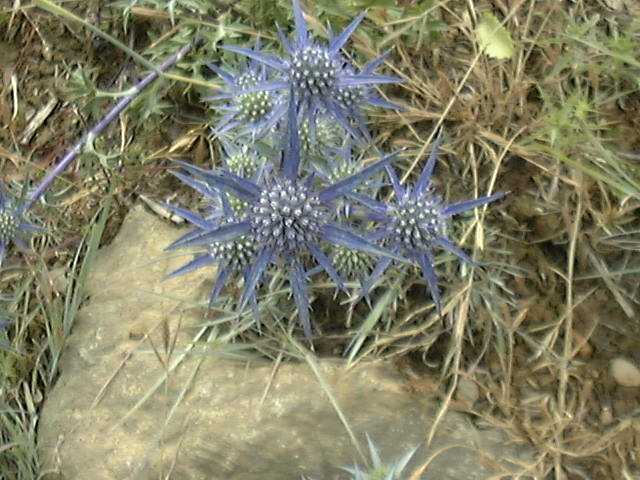 A
carefully constructed 3m wide, dry stone path led up from the road to
nowhere. A sign at the bottom suggested that Ubrique was only 9.5 hours
away. We decided to give it a go. A
carefully constructed 3m wide, dry stone path led up from the road to
nowhere. A sign at the bottom suggested that Ubrique was only 9.5 hours
away. We decided to give it a go.
As we walked up the hill we regularly heard goat bells and occasionally
saw them in a field but although we heard the whoops of the shepherd we
never actually saw them. I imagined them lying in a sleepy hollow
somewhere only waking to make the occasional whoop. We kept our eyes open
for the rare Ibex, a type of mountain goat but all we ever caught a
glimpse of was the common mountain cow. At the top of the first hill we
get a good view of Jimena with its castle on the top of its hill. In the
far distance to the south we can see the Rock of Gibraltar and to the east
the Sierra Bermeja. Along the path we see so many butterflies of differing
size and colour, more than I have ever seen in the wild. There are strange
many legged creatures, flying things, crickets with blue wings. Perhaps it
is because this is a national park, or the farming is not intensive or
fewer pesticides are used. Either way it is good.
We find a spot where a cool scented breeze wafts up through the shade of
some pine trees and sit down for lunch. Then we lie down and then we dose.
Back down in the previously deserted camp site the Spanish have arrived
for the weekend and the Gibraltans for a bank holiday weekend and filled
up the place. The peace is shattered so we plan our escape. But first,
dinner. This will be our last dinner in out little cabin so we make it
last till 11pm; melon and ham followed by beans and asparagus finished
with a citrus cheesecake and washed down with lots of local wine. We slept
well that night. |
|
Sunday 18th June 2006
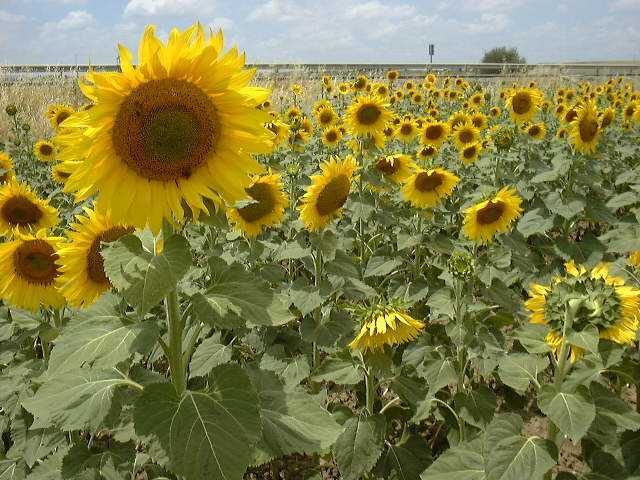 The
morning was surprisingly quiet so that the birds and the bees could still
be plainly heard. Anyway, we have had enough of Jimena so we made a break
for the hills and Sevilla. After the mountains, the landscape falls to
rolling hills of cultivated fields. The The
morning was surprisingly quiet so that the birds and the bees could still
be plainly heard. Anyway, we have had enough of Jimena so we made a break
for the hills and Sevilla. After the mountains, the landscape falls to
rolling hills of cultivated fields. The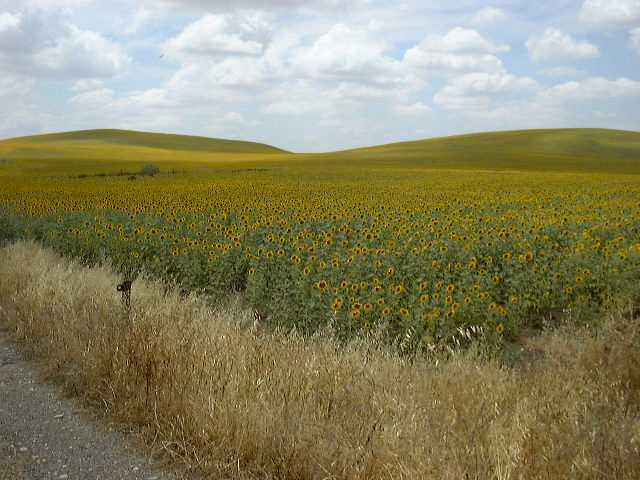 y
love their sunflowers here and sometimes they cover entire hills. We find
Sevilla rather difficult to navigate with its shortage of road signs,
redirections, one-way streets and closed roads. Parking is almost
impossible. Finally we find a little hostel named 'Atenas' which appears
to be no more than a door in a wall but turns out to be more like a hotel.
By this time we need a beer but as our map seems to bear little
resemblance to reality so we go out for a wander leaving a paper trail of
useless maps to return by. At last we find the café district and settle
down for beer and tapas. Hundreds of house martens zoom and swoop up and
down overhead screeching as they go. No matter how many flies they catch
there are always enough to irritate us. y
love their sunflowers here and sometimes they cover entire hills. We find
Sevilla rather difficult to navigate with its shortage of road signs,
redirections, one-way streets and closed roads. Parking is almost
impossible. Finally we find a little hostel named 'Atenas' which appears
to be no more than a door in a wall but turns out to be more like a hotel.
By this time we need a beer but as our map seems to bear little
resemblance to reality so we go out for a wander leaving a paper trail of
useless maps to return by. At last we find the café district and settle
down for beer and tapas. Hundreds of house martens zoom and swoop up and
down overhead screeching as they go. No matter how many flies they catch
there are always enough to irritate us.
|
|
Monday 19th June 2006
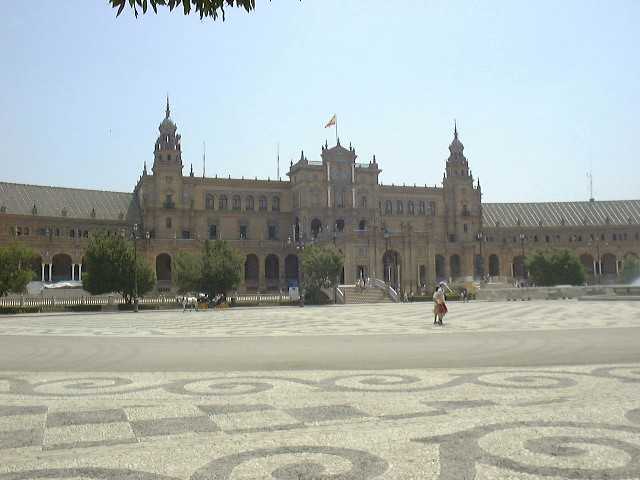 We
have given ourselves a day see Sevilla which seems more than enough. From
what we have seen so far it is just another busy, noisy, smelly city so we
head for the parks and river. All the streets are narrow and one-way for
cars with little or no pavement. The little parks are a nice escape from
the traffic and the trees give welcome shade from the sun. The 'Plazza de
Espania' built in 1929 is a lovely piece of architecture with a great
sweeping arc around an inner arc shaped pond, plaza and central fountain.
The pond is currently dry for restoration to the ornate bridges over it. We
have given ourselves a day see Sevilla which seems more than enough. From
what we have seen so far it is just another busy, noisy, smelly city so we
head for the parks and river. All the streets are narrow and one-way for
cars with little or no pavement. The little parks are a nice escape from
the traffic and the trees give welcome shade from the sun. The 'Plazza de
Espania' built in 1929 is a lovely piece of architecture with a great
sweeping arc around an inner arc shaped pond, plaza and central fountain.
The pond is currently dry for restoration to the ornate bridges over it.
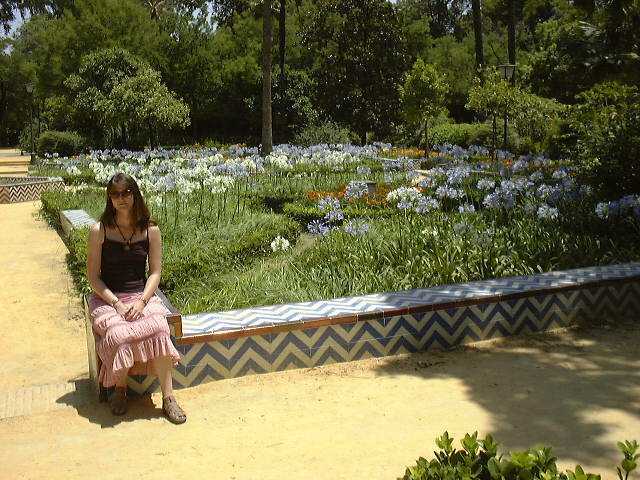 There
are so many little churches down the little narrow streets they must have
to compete for their congregation. The main streets are lined with orange
trees which is not much of a surprise but the oranges look like they have
been left there rather too long and have gathered a layer of dust. It is
38°C in the city by now but the local men are still wearing trousers
instead of shorts but do not appear at all hot. There
are so many little churches down the little narrow streets they must have
to compete for their congregation. The main streets are lined with orange
trees which is not much of a surprise but the oranges look like they have
been left there rather too long and have gathered a layer of dust. It is
38°C in the city by now but the local men are still wearing trousers
instead of shorts but do not appear at all hot.
The cathedral is spectacular inside and out, much like the ones we have in
England. As hoped it is cool inside so we sit for a while to take it all
in.
Back out in the heat there are hundreds of tiny streets to explore and if
you are careful you can pick the ones too small for cars to go down. 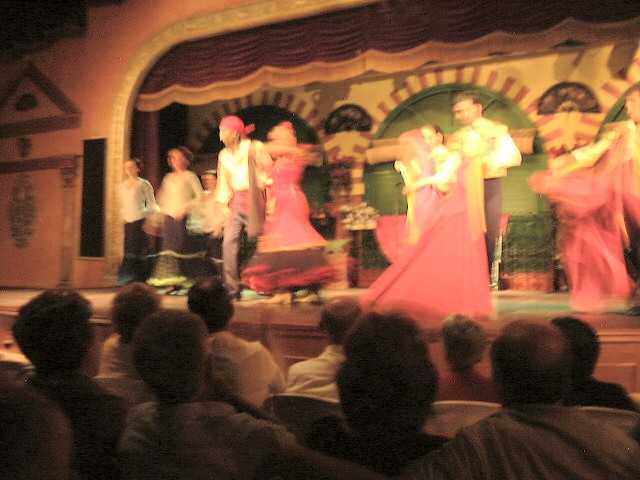 Colourful
tiles and pottery seem to be a favourite in the trinket shops so we buy a
few house numbers to take home. Colourful
tiles and pottery seem to be a favourite in the trinket shops so we buy a
few house numbers to take home.
Finally it is time for beer and tapas again. One of the dishes we pick is
blood pudding in pastry which turns out to be just like Yorkshire black
pudding in filo pastry, right down to the plastic packet the black pudding
comes in.
A short walk up 'Maria Auxiliadora' brings us to 'El Palacio Andaluz'
where we have booked to see a show of Flamenco dancing and music. The
guitar, singing and girls in fancy dresses are great but I can do with out
the stamping of feet.
|
|
Tuesday 20th June 2006
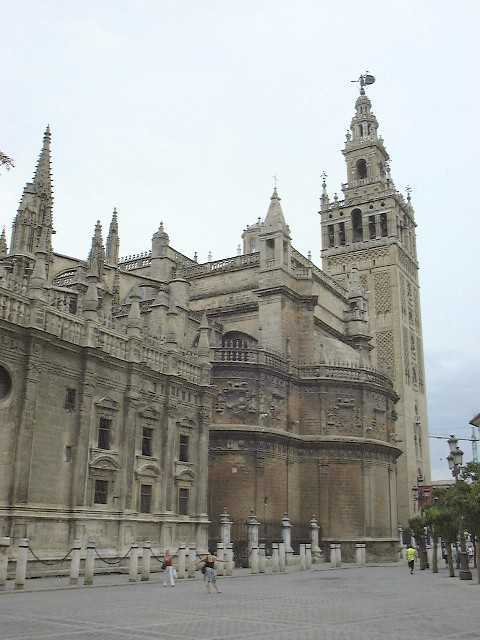 Tracy
devises a cunning plan to extricate us from the warren of crazy one-way
streets of Sevilla and out to the hills of the north. It is 33°C by
midday and even in the hills it does not feel cooler. The landscape is
hilly but not quite mountainous with rocky, sandy red soil that eucalyptus
seem to like growing in. It reminds us a little of the outback of
Australia. I would not be surprised to spot the odd Koala. Tracy
devises a cunning plan to extricate us from the warren of crazy one-way
streets of Sevilla and out to the hills of the north. It is 33°C by
midday and even in the hills it does not feel cooler. The landscape is
hilly but not quite mountainous with rocky, sandy red soil that eucalyptus
seem to like growing in. It reminds us a little of the outback of
Australia. I would not be surprised to spot the odd Koala.
Our map shows two campsites near 'Cazala de la Sierra' but all the road
numbers have changed since our map was printed last year! And even so
there are very few road signs so we have to traverse each road in search
of a campsite. Down one of these routes we come across another lake that
on the map looks to be a vast blue expanse and we imagine it to be
surrounded with trees, grass, flowers and have people splashing joyfully
in the water or have boats sailing gently upon it. We envisage log cabins
for us to stay in with little bars serving cold drinks. But no, this is
just a mirage if the mind brought upon by heat stroke. Out of the car the
air smells like it has been baked relentlessly for weeks. The water is a
pitiful puddle within a dusty valley surrounded by the parched twigs of
desiccated plants. No one but us has ventured down the bumpy track to this
desolate spot.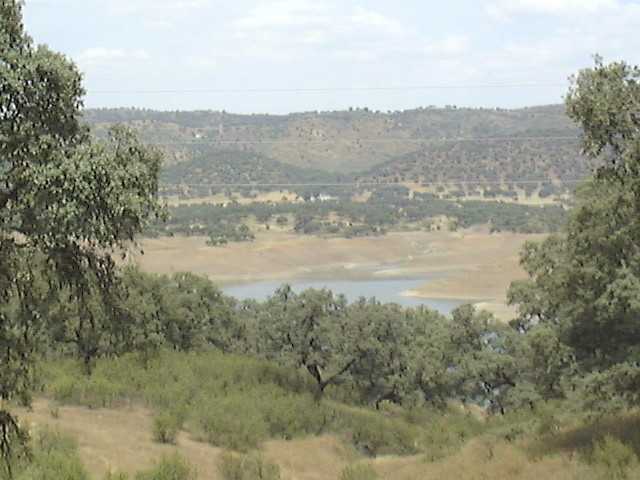
We finally find a campsite in a greener, more welcoming part of the hills
but are told that there are no cabins or caravans to rent and are directed
back to Cazella. We head on to Constantina instead where there is supposed
to be a hostel. It turns out to be a youth hostel and full of noisy
youths, not the place for us. This place must be well off the tourist
track for there are very few hotels or hostels and absolutely no B&Bs.
We finally find a hostel in Cazalla but it is closed. Everyone we ask
about the campsite directs us back to San Nicholas. We end up settling for
the only, and far too posh hotel in Cazalla. Still, we do find a nice
little bar in town for beer and tapas and then stroll back through town
watching the swarms of House Martens filling the skies and the storks
fussing about their chimney top nests. While wandering we stumble across
the Tourist Information office, which is only open from 10am to 2pm so it
never would have been any use to us. We decide to visit it in the morning.
The hotel is very nicely presented, reminding me of a Roman country villa
with a horseshoe shape of connected buildings around a central courtyard
containing fountains and potted plants. Around the corner a swimming pool
afforded us a cooling dip. It was a nice place but a little too
pretentious for me.
|
|
Wednesday 21st June 2006
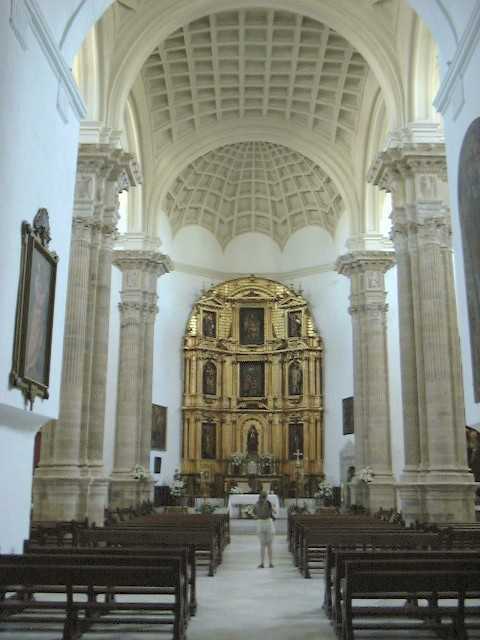 Up
at the tourist office a little sign says something like 'back in 10
minutes' so we take a look at the church to pass the minutes. A little old
lady sitting outside lures us into the church. She shows us all the
treasures inside while speaking in rapid Spanish. To my mind the inside is
more agreeable that the cathedral in Sevilla which was so full of detail
it was hard to know where to start looking so that in the end I felt that
I had missed most of it. Here, the treasures could be viewed easily in a
few minutes, after which I felt ready to move on to the next. The exterior
of the church did not reflect the beauty of the interior so that if we had
not been lured inside I might have dismissed it as derelict. Up
at the tourist office a little sign says something like 'back in 10
minutes' so we take a look at the church to pass the minutes. A little old
lady sitting outside lures us into the church. She shows us all the
treasures inside while speaking in rapid Spanish. To my mind the inside is
more agreeable that the cathedral in Sevilla which was so full of detail
it was hard to know where to start looking so that in the end I felt that
I had missed most of it. Here, the treasures could be viewed easily in a
few minutes, after which I felt ready to move on to the next. The exterior
of the church did not reflect the beauty of the interior so that if we had
not been lured inside I might have dismissed it as derelict.
Back outside, the tourist office was still closed but after I rattled the
door someone came to open it. After trying the campsites for us without
success he tried a 'rural house', which turned out to be better than we
had ever hoped for. Only 4km out of town but off the beaten track, a
little white house stands alone on the hillside but shaded by trees. 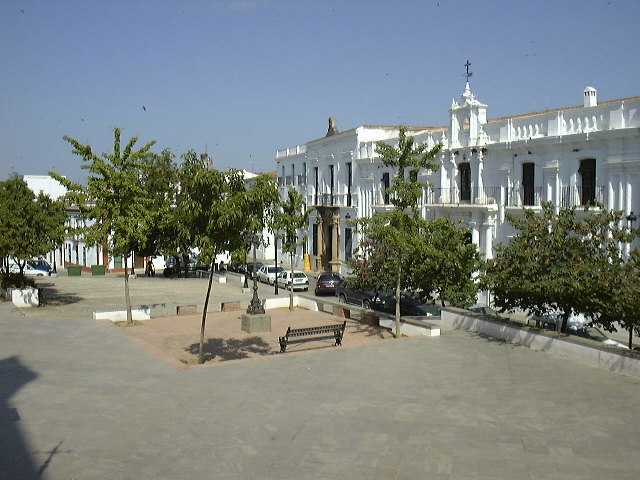 With
its own garden, patio, pool and barbeque, excellent views and the
possibility of good walking it is the ideal spot. Once the owner had
driven off, the only sounds were the birds, crickets, the occasional cow
bell or dog barking. We felt very alone. In fact, when we looked at the
surrounding hills there was no sign of any other habitation. Even the dogs
were housed in old farm buildings with no one else around. By this time it
was midday and getting very hot so we had lunch and relaxed by and in the
pool. With
its own garden, patio, pool and barbeque, excellent views and the
possibility of good walking it is the ideal spot. Once the owner had
driven off, the only sounds were the birds, crickets, the occasional cow
bell or dog barking. We felt very alone. In fact, when we looked at the
surrounding hills there was no sign of any other habitation. Even the dogs
were housed in old farm buildings with no one else around. By this time it
was midday and getting very hot so we had lunch and relaxed by and in the
pool.
By the time dinner was over it was cool enough to walk down the steep
slope from the garden to the valley far below. The sweet smell of herbs
wafted past our noses borne upon the warm evening air but we could only
recognise sage and lavender from the selection around us. Most of the
other plants were just spiky things growing out of the dry red dust and
rocks. A scattering of dry leaves and bark smelt as if they had been baked
for a long time.
We tried to reach the stream running along the bottom of the valley but it
is hidden by a protective thicket of vegetation and barbed wire so we head
back up the track before it gets too dark. Chilled red wine and chocolate
cake awaits us.
|
|
Thursday 22nd June 2006
This is such a peaceful idyllic paradise that we do not want to move. 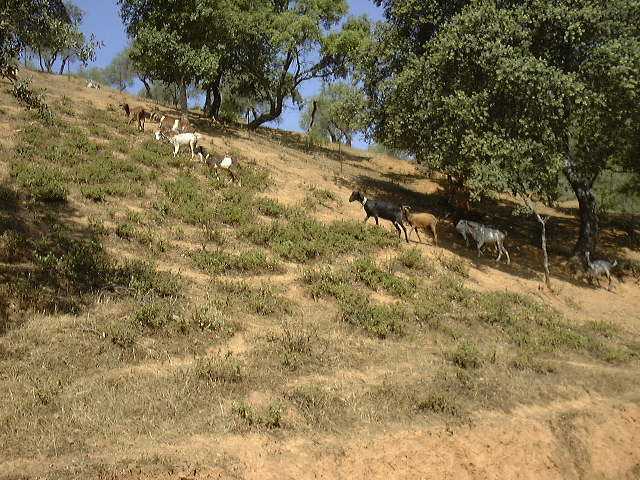 Fortunately
we have everything we need so after a short stroll up the hill to verify
that everything up there looks just the same as down the hill, we settle
in for a day of R&R. Occasionally we stopped to check that the
temperature of the pool was just right or that the scenery had not changed
but other than that we just relaxed. I would have liked to find a
thermostat to turn the temperature down a little bit. Every now and then
someone would open an oven door and a great wave of baked air would waft
over us. Some of the cicadas sounded just like automatic lawn sprinklers,
even down to the pause as the jet moves back to the start. Unfortunately
it was just the cicadas and there was no cooling spray. A highlight of the
day was watching the trains trundle up and down the valley far below us. Fortunately
we have everything we need so after a short stroll up the hill to verify
that everything up there looks just the same as down the hill, we settle
in for a day of R&R. Occasionally we stopped to check that the
temperature of the pool was just right or that the scenery had not changed
but other than that we just relaxed. I would have liked to find a
thermostat to turn the temperature down a little bit. Every now and then
someone would open an oven door and a great wave of baked air would waft
over us. Some of the cicadas sounded just like automatic lawn sprinklers,
even down to the pause as the jet moves back to the start. Unfortunately
it was just the cicadas and there was no cooling spray. A highlight of the
day was watching the trains trundle up and down the valley far below us.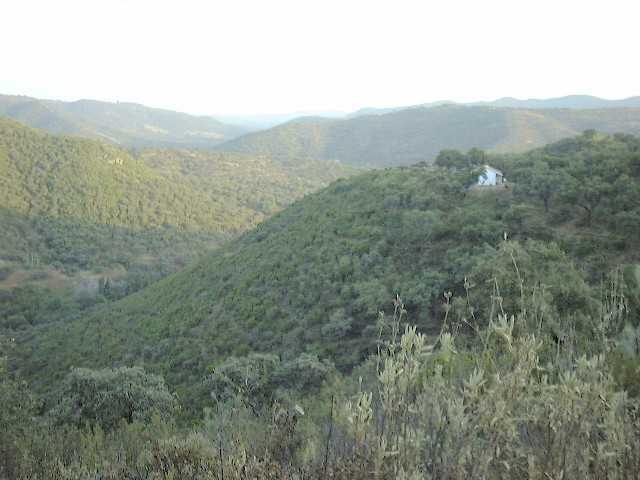
In the evening as the sun was going down and the air was cooling, although
imperceptibly, we went for a walk up the dirt track that led to the tarmac
road over the hill somewhere. We stopped to feed the remains of our pasta
dinner to the big dog that had been chained to a tree since we had
arrived. It was a friendly and placid dog although very big and we were
secretly pleased that it was chained, as it would have bowled us over in
its excitement to see us. The herd of goats soon came along on their
evening stroll so we joined them for a walk to the gate that was guarded
by slightly smaller but more timid dogs. The dogs and goats seemed to hang
out together like best mates, which seemed a little odd to me.
Past the gates a herd of pigs in a pen rushed up to oink at us and try
their best to wag their curly little tails. Just around the corner a cage
full of dogs barked in a most unwelcoming manner but were nothing compared
to those further up the hill that growled and bared their teeth until I
said 'boo', whereupon they ran and hid. Just to complete the menagerie
there was also a rabbit enclosure.
From the top of this hill we could see our own house across the valley in
one direction and some other houses in the valley on the other side so we
were not quite as alone as we felt.
|
|
Friday 23rd June 2006
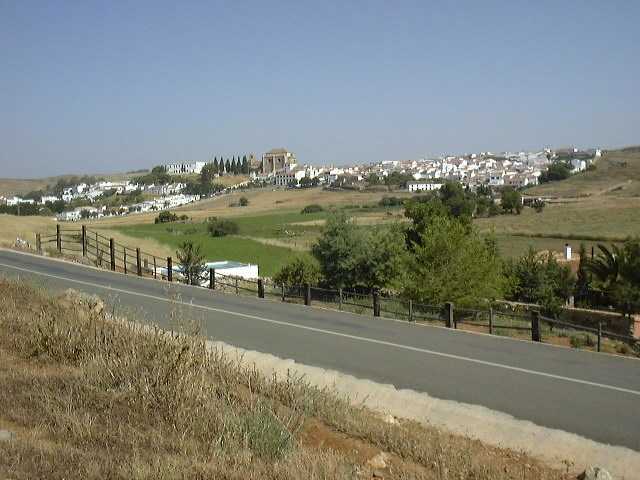 With
great reluctance we left our remote rural house in the hills and drove
south through the winding roads of the 'de la Sierra Norte' and out onto
the flat plains of Sevilla. Through the fields of sunflowers and orchards
of oranges we drove, past the industrial sprawl of Sevilla and down the
motorway, past Jerez and way down to Tarifa. This little town claims to be
the most southerly point in Europe. In the centre is an old walled town
with narrow, quiet streets full of bars and restaurants. Outside the walls
an urban sprawl has grown and outside that hostels line the beach road.
Tarifa is known as the wind surfing and kite surfing capital of Spain but
could also be termed the windmill capital for the hilltops all around are
smothered with them. We end our culinary tour of Spanish food with pizza
and sangria at a little café just outside the walls. With
great reluctance we left our remote rural house in the hills and drove
south through the winding roads of the 'de la Sierra Norte' and out onto
the flat plains of Sevilla. Through the fields of sunflowers and orchards
of oranges we drove, past the industrial sprawl of Sevilla and down the
motorway, past Jerez and way down to Tarifa. This little town claims to be
the most southerly point in Europe. In the centre is an old walled town
with narrow, quiet streets full of bars and restaurants. Outside the walls
an urban sprawl has grown and outside that hostels line the beach road.
Tarifa is known as the wind surfing and kite surfing capital of Spain but
could also be termed the windmill capital for the hilltops all around are
smothered with them. We end our culinary tour of Spanish food with pizza
and sangria at a little café just outside the walls.
Index |